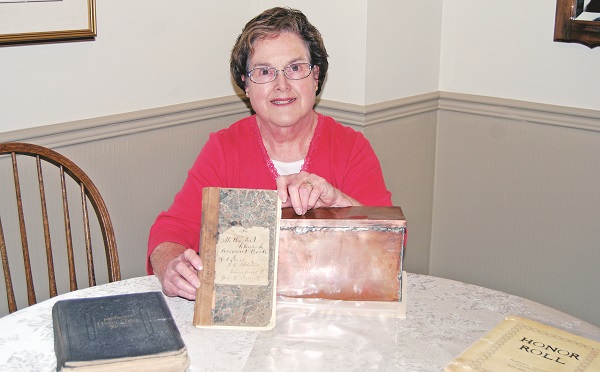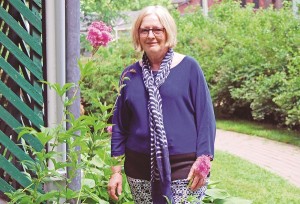Archive
Aurora United Church fire began journey of re-discovery leading up to new exhibition
July 16, 2014 · 0 Comments

By Brock Weir
In the hours after Aurora United Church went up in flames last April, long-time church historian Helen Roberts found it difficult to find the right words to express just how she felt.
In the intervening months, however, she has hardly had time to set her thoughts down as she eagerly took up a journey of re-discovery, poring over what was salvaged from the ashes.
As keeper of the church’s history, Ms. Roberts knew where to look when guiding demolition and heritage experts to find hidden caches of the church’s history. Walls were felled by shovels, filing cabinets were mangled in the process, but after they were loaded onto trucks and taken to restoration experts in Hamilton, they were able to untangle the treasure inside.

Claire D’Aurore
Before the fire, these materials might not have been considered “treasure”, but with precious little remaining of the archives, everything has acquired a newfound appreciation.
“To me, the most valuable thing that came out of that was the trustees’ account book from 1878 where they tracked costings and payments during that building period,” says Ms. Roberts. “It also covers other costs to the church at that time. It is very difficult to understand because basically all it says is who they paid and how much they paid them, but it doesn’t really say what it was for, but it has managed to survive this long and managed to survive the fire.”
A few months before the fire, books like this were carefully kept in acid-free conservation bags, doubled up with a few trusty Ziplocs to keep out the elements, such as water damage. With the amount of water that was pumped into the church that fateful day, it was a good move.
“It looks as good as it did when I last saw it,” says Ms. Roberts.
Some items, however, clearly weren’t so fortunate. Minutes taken from meetings during that crucial building period are still unaccounted for in the material they have been going through, but other items, including numerous Sunday School records that had been donated by parishioners, hymn books dating from the late 1800s, newspaper clippings, and a photographic record of each parishioner before they embarked to fight in the Second World War, came out slightly singed but remarkably unscathed.
Just two short months ago, all these papers were handed back to an excited Ms. Roberts by Rev. Andy Comar, along with time capsules salvaged from 1975 and 1986, survivors of what might have been a series of three capsules, with a rumoured first from 1878 being lost to the ages.
“I was pretty excited,” says Ms. Roberts of being handed back the material. “By the time I got home [from the church council meeting] it was well after 11 p.m. and I emailed [Revs. Andy and Lorraine Newton Comar] back saying, ‘No sleep tonight! I am too busy looking at all this wonderful stuff in here.’
“If I had my choice of what I would really have liked to have seen, this might not have been the prime thing, but knowing where these archives were, and where the fire was, I could just not believe anything would have survived. I was absolutely stunned they could have saved any of that.”
A selection of these great survivors will be on hand in a new exhibition “AUC Alive”, which opens this week in the Aurora Room at the Aurora Cultural Centre. What has been salvaged will be contrasted with evocative images taken in the aftermath of the fire by Aurora photographer Claire D’Aurore.
Ms. D’Aurore, a native of France, has always been drawn to nature images, but driving down Yonge Street a couple of days after the fire, something caught her eye.
“I saw the sun steaming down the stained glass windows there and I thought it looked amazing and I had to go home and get my camera,” she says.
She entered one of these initial images into the annual Juried Art Show and Sale hosted by the Town of Aurora in the “Preserve Aurora” category and her image of the stained glass was purchased by Councillor John Abel, who has loaned it back for the AUC exhibition.
“Being French and living in Europe, I had the idea in my mind that the façade would be saved, but I didn’t realise it is not stone and it reacts differently when you pour cold water on it. Following that first time I took photos, I went back to take more, trying to get different angles and things. As it was being torn down I took more photos.”
Helping her break away from her regular leanings towards nature was an admiration of Toronto photographer Edward Burtynsky who, in addition to his photography capturing the industrial world, can also shed light capturing when things go wrong.
“I find there is always beauty if you look for it in almost anything,” she says, noting the church was more than just a spiritual home, but a community hub for non-denominational groups. “I want that to continue in some fashion to get the townspeople together as a community.”
As such, proceeds from the sale of prints of Ms. D’Aurore’s photos in the exhibition will be donated to the AUC’s rebuilding fund.











